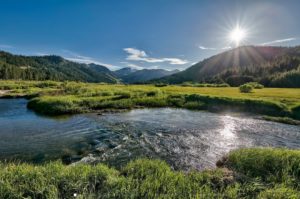PLACER COUNTY SUPERVISORS VOTE TO APPROVE SQUAW VALLEY VILLAGE PROPOSAL
After a ten-hour, emotional public hearing in North Tahoe today, the Placer County Board of Supervisors voted to approve the Proposed Village at Squaw Valley project, the biggest development ever proposed for North Lake Tahoe. Going in, there was really only a dim hope that something different would happen yesterday. And that hope died almost right away. What happened? Squaw Valley CEO Andy Wirth got his meeting with the California Attorney General’s office, and someone in the AG’s office rolled over. Squaw Valley volunteered to pay $440,000 to the Tahoe Regional Planning Agency to mitigate the possible effects of increased traffic on Lake Tahoe from the proposed Village project. In return, the AG’s office agreed not to file suit over the approval of the project, and the County refused to concede that there is a connection between traffic in the Basin and loss of lake clarity. The standing room only audience responded with jeers and boos. For KSL, a private equity firm based in Denver, the vote was a victory against an overwhelming opposition to their proposal, including every conservation group in the region and more than five thousand Tahoe-lovers who signed a petition to stop the project. But after the Martis West approval, everyone knew where the Supervisors interests lay. Hundreds of local residents, small business owners, and second homeowners packed the North Tahoe Events Center. KSL bused in employees and supporters – even offering free breakfast, lunch, and dinner. The first hour of the meeting featured a parade of KSL consultants and County staff, touting the project and urging approval. Alex Fisch, Placer County Senior Planner, gave an overview of KSL’s proposal and application for development entitlements. He described Squaw Valley as “somewhat blighted” and claimed destruction of viewsheds would not be a problem for new visitors, because they wouldn’t know what Squaw Valley had looked like before the construction of the new highrises. Addressing issues of public safety wildfire danger, Fisch said that the existing parking lot is the current location for “shelter in place” emergency response and that KSL has “agreed to continue to provide that public service.” When the Board opened the hearing to public input, scores of speakers lined up to address the Supervisors. By Unofficial Alpine estimates, of the 300 to 400 people in the room, approximately 110 people provided public comments. About 80 of the people who spoke asked for a reduction in the size of the project. Approximately 25 people spoke in favor of the proposal, mostly people on Squaw’s payroll, or who own businesses that are likely to benefit from the expansion. Three people either stated that they were neutral or spoke in circles in a way that left many scratching their heads. Some notable oomments: Katy Hover-Smoot read a letter from her grandfather, a 91-year old World War II veteran unable to attend in person. After the war, he found refuge in the mountains of Tahoe. He asked the Board to “act in the interest of future generations” and deny the project. Shannon Eckmeyer of the League to Save Lake Tahoe pointed out ways in which the development undermines ongoing efforts to “Keep Tahoe Blue”. An environmental attorney by trade, she told the Board that the environmental impact report for the project was “the worst environmental review I’ve ever read.” Tony Lashbrook, Town Manager of Truckee, pointed to one of the biggest issues in the region, “lack of housing is a critical problem.” And the KSL proposal would make the workforce housing worse. This housing crisis issue was brought up by many others as well. Local resident and business owner Jennifer Gurecki slammed the project saying “Outdoors are the backbone of this economy,and this development threatens that.” Probably the highlight of the comments was when fourteen-year-old Kate Gaffney spoke on behalf of a group of local high schoolers. She questioned the need for an indoor waterpark in her mountain home. “Don’t believe them when they say kids want a waterpark in the mountains cuz we don’t.” Alexis Ollar spoke on behalf of Truckee-based conservation group Mountain Area Preservation. “We have the best waterpark in North America seven miles down the road. It’s called Lake Tahoe,” said Ollar. “Please deny the project because Squaw and Tahoe deserve better.” A group of 5 from the Friends of Olympic Valley gave a sequenced presentation that showed Squaw Valley did not need the 850 proposed units to be competitive by KSL’s own metric of units per skiable acre. Rather 550 would suffice. They also pointed out numerous flaws in the financial evaluation of the dEIR Reduced Density Alternative that the Squaw Valley MAC had preferred. And finally they presented a 65% alternative that would provide 550 units (thereby hitting the competition “benchmark”, and achieve the required 12% minimum Internal Rate of Return financial hurdle. Isaac Silverman, Sierra Watch Staff Attorney, reminded the Supervisors that “State law prohibits you from approving KSL’s proposal when a better plan is feasible.” Ultimately, this proposal was shot down because it would only provide payments for the renovation of Squaw Creek, local parks and trails and transportation initiatives in proportion to the number of units. Some audience members spoke in favor of the proposed development. Squaw Vice President Casey Blann urged approval so that North Lake Tahoe could “keep pace with development in South Lake Tahoe.” At the end of public comment, the Board of Supervisors was ready to discuss the question before them. Supervisor Jim Holmes praised the developer for doing “a great job”. Supervisor Jack Duran said it “was a very difficult decision”. But that there would be opportunities to further evaluate the project and “refine things as we move down the road.” Supervisor Jennifer Montgomery, whose district includes Squaw Valley and North Lake Tahoe, explained why she was voting against the project. She said she “relied on head, heart, and gut to make a decision.” And that, for her, the most basic question was “What’s my job and to whom do I owe allegiance and responsibility in this situation?” “People really do want change,” she continued. “They want to see a better village. They are just not convinced that this is the project that will get us to their goals. I heard very loud and clear, that the vast majority of my constituents don’t want this. They almost all asked for something smaller.” When the Board concluded its discussion, Supervisor Montgomery made a motion “to reject the project in front of us and evaluate the 65% proposal” that had been made by the Friends of Olympic Valley. The motion died for lack of a second. Supervisor Uhler moved quickly to approve the project, making a series of motions, each quickly seconded and approved with 4-1 votes, Supervisor Montgomery casting the lone “no” votes. So the public part of the process is over for now. It’s safe to say that we are likely still years away from a shovel of dirt being turned. The next step is likely litigation as Sierra Watch is committed to take KSL and County to court. And even after that, each individual component of the project will again need to go through that standard planning process at Placer County. .

